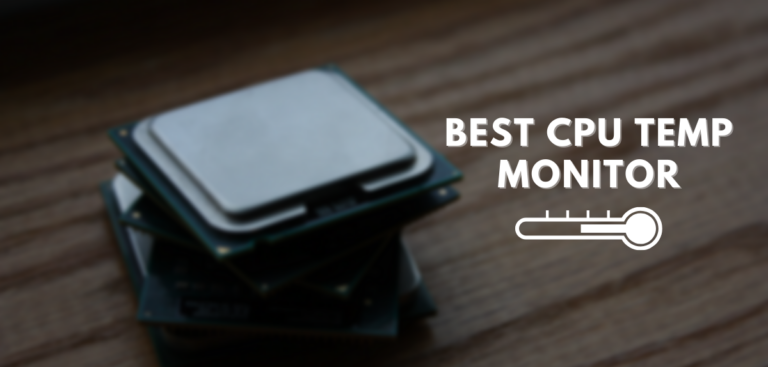If you’re a fan of overclocking, monitoring your computer’s interior temperatures is more important. High-temperature CPUs have a severe impact on performance and shorten the life expectancy of your hardware. Gaming and workstation PCs both necessitate CPU temperature monitoring. For those who want to keep an eye on their computer’s temperatures, several effective CPU temp monitor options are available. In this post, we’ll show you the best free CPU monitors.
Let’s not waste any time and get started right away!
The Best CPU Temp Monitor Tools In 2024
In this article you can find out the best CPU Temp Monitor tool to check CPU temperature.
1. HWMonitor – Best CPU Temp Monitor
HWMonitor is a fantastic tool for monitoring various hardware parameters, including CPU temperature. GPU temperatures, fan speeds, storage devices, and a slew of other hardware outputs may all be monitored with this easy-to-to-use program. A simple and useful tool like HWMonitor would be ideal for anyone seeking a good starting point.
2. Core Temp – Easy to Use CPU Temp Monitor
Core Temp is a simple monitoring tool that does exactly what the name suggests: it keeps tabs on the temperature of your CPU. The CPU temp monitor is simple and does not require any additional hardware to work. The only downside is that it can’t monitor your CPU’s core temperatures and power consumption.
Many users prefer this CPU temp monitor because of its straightforward interface and useful features.
3. Open Hardware Monitor – Advanced CPU Temp Monitor
HWMonitor and Open Hardware Monitor provide similar functionality and monitoring capabilities; however, Open Hardware Monitor is slightly more advanced. Open Hardware Monitor has more monitoring options than Core Temp, including clock speeds, load, and power consumption. Temperatures, load, fan speed, and clock speed are all visible in the GPU itself.
If you don’t like HWMonitor, Open Hardware Monitor is a fantastic option. It provides a lot of freedom.
4. Speed Fan – CPU Temp Monitor With Simple UI
For those who like a more vintage look, Speed Fan could be the CPU temp monitor of choice for you. For monitoring software it’s fairly advanced, despite its simplicity of design. As a result, users will be able to configure a more efficient fan design than the pre-installed one on their computers.
Using Speed Fan, you can check the CPU and GPU temperatures and the total temperature of your computer.
5. Real Temp
Real Temp, like Core Temp, shows only CPU temperature data. This CPU temp monitor has an easy-to-use design to check your processor’s internal temperature quickly. Real Temp displays the lowest and maximum CPU temperatures compared to other tools, allowing you to compare various conditions swiftly.
If your CPU is nearing TJ Max – the maximum temperature at which it will be throttled – you can see how close you are.
6. CPU Thermometer
There comes CPU Thermometer, a simple and effective tool for monitoring the heat of your computer’s processor. It looks a lot like HWMonitor and Open Hardware Monitor in its design. However, GPU temperature measurements are absent from this tool.
Other CPU temp monitor tools described in this article include similar features to CPU thermometers, including clock speeds, CPU core temperatures, and overall power consumption.
7. Speccy
With Speccy, you can keep tabs on not only the CPU and GPU but also the complete PC. For more than just monitoring your system’s temperature, Speccy delivers a comprehensive overview of your PC’s components.
This may be a great way for those attempting to sell their PC to demonstrate the hardware configuration. In addition, reading temps while keeping tabs on your CPU/GPU is made easier thanks to the display’s great visuals.
8. Aida64 Extreme
Aida64 is an all-in-one tool for performance testing and system health monitoring. A wide range of useful features, including hardware monitoring, integrated benchmarking tools, stress testing, and diagnostics.
Even though Aida64 Extreme is the most versatile tool on this list, it is also the most expensive. You’ll pay a premium for this, but you’ll get unparalleled functionality in return.
9. MSI Afterburner
MSI Afterburner is the last but most certainly not the least. However, for those who have never heard of MSI’s monitoring tool, it is one of the best applications for monitoring your computer’s temperature. Like the vast majority of gamers, we utilize MSI Afterburner to test our PCs’ performance in games. On the other hand, Afterburner by MSI is an all-in-one benchmarking tool that includes numerous extra features. ‘
How to Monitor Your CPU’s Temps?
Using the best CPU temp monitor, we’ll briefly go over how to read your CPU temps.
Fortunately, using any of the tools on this list is a cinch. Each one has a user-friendly interface. In most cases, all you have to do is download, install, and run the application.
When the program is opened, it will always show the current CPU temperature. Even though some may necessitate a few mouse clicks, they’re all very user-friendly.
What Is the Purpose of Monitoring Computer Temperatures?
Many people first start keeping track of their computer’s temperatures when they notice a decrease in performance or add a new component.
First, let’s take a look at what causes a computer to overheat in the first place, and then we can compare various computer temperature monitoring tools.
CPU
Whether it is an AMD or an Intel chip, modern CPUs can handle a lot of heat before failing. It’s still important to keep your CPU cool, so many come equipped with a stock cooler (apart from high TDP CPUs). Having a cooling that isn’t powerful enough for your CPU can cause it to overheat. If you didn’t correctly install the cooler, there could be gaps that reduce the cooler’s efficiency. Out-of-date or incorrectly placed thermal paste is the primary cause of elevated CPU temperatures.
Regardless of the reason, keeping an eye on your CPU’s temperature will alert you if it gets too warm.
GPU
The graphics card is almost certainly the most powerful component in terms of thermal dissipation. You can find one, two, or three fans on aftermarket GPUs to evacuate the heat created by the card and actively cool it down.
Most high-end graphics cards use passive cooling to attain the best of both worlds in terms of acoustics and cooling. Your graphics card’s fans won’t turn on until the CPU has reached a certain temperature. It’s a good idea to keep an eye on your graphics card’s temperature with a tool because it generates heat.
Dust
Personal computers can’t help but collect dust. Fans and heatsinks lose efficiency and airflow since there’s no way to prevent dust from getting inside.
Verdict
CPU temp monitor tools abound, and most of the work admirably. Keeping an eye on your system’s health is essential, as a sick system will cost you a lot of money to replace.
Tools like these can provide crucial information about the behavior of individual components, which can help prevent overheating of a CPU or GPU before it gets out of hand.



